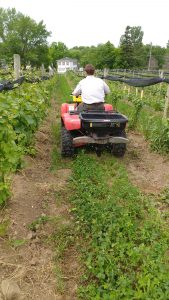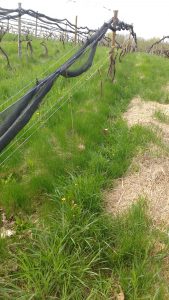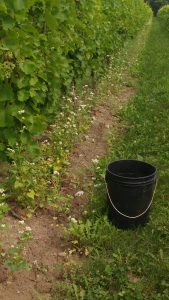Final report for LNE17-360
Project Information
The usual under-vine management practice in the Northeastern USA a 3-ft herbicide strip to reduce competition for the vines. Most growers spray at least three herbicide application per year, with application costs of approximately $220/acre/year. This open soil is susceptible to erosion as well as herbicide runoff/leaching. Through a series of experiments we have developed recommendations for replacing herbicides with under-vine cover crops. This project aims to engage all 200 winegrape growers in the Finger Lakes Grape Program through a comprehensive educational program so that more growers adopt this environmentally and economically sustainable practice. We worked directly with Finger Lakes grape growers to help them trial a range of under-vine cover crops. Twenty-four grape growers involved in this effort verified their intention to continue to experiment with under-vine vegetation in their vineyards in the future.
50 New York State (NYS) winegrape growers replace herbicides with annual under-vine cover crops on a total of250 acres, reducing production costs by at least $150 per acre per year.
Through a series of six research experiments we have developed recommendations for replacing herbicides or cultivation with under-vine cover crops. This project engaged all 200 winegrape growers in the FLGP through a comprehensive educational program as well as other grape growers around the Northeast through social media. Educational approaches included viewing a professional video to learn about the use of under-vine cover crops in vineyards, presentations at cooperating vineyards so growers could personally evaluate the impact of the practice, one-on-one meetings with the project team, and grower discussions to maximize peer learning. All growers interested in experimenting with under-vine cover crops were personally assisted with cover crop seeding, establishment, management, and evaluation of the practice.
Research
Education
Educational approaches include viewing a video to learn about planting under-vine cover crops, presentations at cooperating vineyards so growers can evaluate the impact of the practice, one-on-one meetings with the project team, grower discussions to maximize peer learning, and final delivery of outcomes via a Cornell Cooperative Extension podcast.
Milestones
200 grape growers view video and learn about under-vine cover crops, and the benefits of using them overherbicide/cultivation; 50 NYS grape growers respond via online form to express interest in trialing under-vinecover crops (December 2017).
200
1026
December 31, 2017
Completed
May 30, 2018
The informational video at https://www.youtube.com/watch?v=q7IMzX8e4dI&feature=youtu.be now has >1,000 views (although we don't know how many of those are NY grape producers). Update: As of January 2020, the video has >2,000 views. We advertised on May 2, May 9, and May 31 to recruit growers in the Finger Lakes Grape Program Vineyard Update: https://nygpadmin.cce.cornell.edu/pdf/newsletter_update/pdf438_pdf.pdf
35 grape growers work one-on-one with project team to develop plans to experiment with under-vine cover crops in their vineyards during 2018 season, seed at least one cover crop (June 2018)
35
12
June 30, 2018
Completed
June 29, 2018
 Unfortunately the grower numbers did not get close to our target of 35 (actual number is 12 different growers). We had a good number initially interested but then getting people pegged down for choices was more difficult than I thought. It took more time than I had anticipated so we were able to stop by fewer vineyards nearby to try to attract growers to the project. However many growers experimented with more than one cover crop, and they asked for larger areas to be seeded than I had anticipate
Unfortunately the grower numbers did not get close to our target of 35 (actual number is 12 different growers). We had a good number initially interested but then getting people pegged down for choices was more difficult than I thought. It took more time than I had anticipated so we were able to stop by fewer vineyards nearby to try to attract growers to the project. However many growers experimented with more than one cover crop, and they asked for larger areas to be seeded than I had anticipate

Total seeded area was more than 9 acres. Cultivars included Gewurtztraminer, Pinot noir, Riesling, Cabernet Sauvignon, Concord, Niagara, Lemberger, Cabernet Franc. Cover crops seeded included buckwheat, fine fescue, oats, and chicory.
65 grape growers attend grower-led discussion at collaborating vineyard, personally evaluate use of under-vinecover crops (August 2018)
65
35
August 31, 2018
Completed
August 22, 2018
We had a field meeting at Boundary Breaks on Seneca Lake, with 35 growers attending. We viewed the oats and buckwheat that were seeded into the Riesling blocks there and discussed the benefits of under vine cover crops. Kees Stapel (vineyard manager) spoke about his experience working with them. Results were viewed as positive but it was so dry in the early part of the season that they didn't provide full coverage. Many growers reached out to ask about seeding under vine cover crops in the following year.

25 growers agree to experiment with under-vine cover crops for the first time during 2019 season (August 2018)
25
10
August 31, 2018
Completed
October 31, 2019
We had ten additional growers agree to test under-vine cover crops in 2019 (in addition to the first 12, who have all indicated interest in continuing with this effort) . Update: an additional two growers (for a total of 12) indicated interest for the 2019 growing season.
30 grape growers individually host project team at their vineyard to evaluate impacts of 2018 cover crops(December 2018)
30
11
December 31, 2018
Completed
January 11, 2019
We've been reaching out to the growers we've worked with to get their thoughts during this pruning season (impacts on vine size, etc.). This milestone is in progress. Update: was completed in January 2019, we either visited or at minimum connected via phone. Every grower felt that the germination rate of cover crops were low due to the dry spring of 2018. They did not compete well against weeds for that reason.
20 grape growers work one-on-one with project team to develop plans to experiment with under-vine cover crops in their vineyards during 2019 season, seed at least one cover crop (June 2019)
20
11
June 30, 2019
Completed
June 01, 2019
We have 10 growers who last year indicated at our field meeting that they'd like to participate this coming year. We are actively recruiting more growers as I recognize are participant numbers are not as high as we need! Update: We had 11 growers commit to trialing under vine cover in 2019. We visited with each grower (some at their farms, some at BEV NY meeting, some by phone) to make plans.
50 grape growers who experimented with under-vine cover crops over the course of the project meet with project team to verify outcomes and share information (August 2019)
50
25
August 31, 2019
Completed
November 15, 2019
We ended up with 16 growers who had trialed the practice directly with us (some on multiple blocks/sites) who verified outcomes with us. Most were verified via visiting the farm and talking with the grower, a few were by phone.
We asked the following questions:
What was your overall impression of your cover crop?
Did you notice any impacts on fruit quality?
How well did it establish?
Problems / concerns
Would you be interested in further experimenting with under-vine covers?
However, on Aug. 2 I met with 10 growers who have formed a bio-intensive viticulture group (invited presentation attached)SilverThread_Aug2. Of those 10 grower, every one of them was trialing under-vine growth but only one was in our group of collaborators! So growers trialing the practice that I am aware of was 25.
Milestone Activities and Participation Summary
Educational activities:
Participation Summary:
Learning Outcomes
Our method was to discuss one-on-one with the growers that directly worked with us what their experiences were with under vine cover crops, what they were surprised by, and how the information they gained might guide their practices in the future. The surveys of our collaborating growers were completed in late Fall 2019/early spring 2020. In the Aug 2019 discussion with the bio-intensive group we discussed in-depth what those growers had learned from their experiences. Those growers told me they were inspired by these two articles: https://grapesandwine.cals.cornell.edu/sites/grapesandwine.cals.cornell.edu/files/shared/Research%20Focus%202017-1.pdf and https://grapesandwine.cals.cornell.edu/sites/grapesandwine.cals.cornell.edu/files/shared/Research%20Focus%202018-2%20May.pdf. All 24 growers communicated an interest in further experimenting with under-vine cover (either cover crops or natural vegetation). The major obstacles they communicated were lack of time, need to get to the planting in a timely manner, dry seasons are a problem, and that low-growing covers would be optimal (to reduce need for mowing). Additionally we verified that all 24 growers had ideas for how to seed and maintain under-vine covers in their vineyards in the future.
Performance Target Outcomes
Target #1
24
Further trial (on their own) or adopt annual under vine cover crops in place of herbicides in mature vineyards
250 acres although long-term potential for much more (growers still trialing so assuming those trials are on a small acreage)
Reduced production costs of $150 per acre
24
All 24 growers verified they will continue to experiment on their own with under-vine covers
Potential with these 24 growers for ~480 acres
No change verified. I can estimate these but growers are still trialing rather than full out adopting.
We verified outcomes for 24 growers who trialed the practice in 2018/19 through one-on-one contact or questioning the smaller group of growers (biointensive group). We asked them the questions listed elsewhere in this report but it was very conversational in style with some growers providing more information. There are two aspects of the project not fully achieved: 1) full-on adoption of the practice. All growers indicated they were interested in further trialing under-vine cover on their own, in different farm blocks. I consider that a success after working with them only one or two years, particularly because the spring of 2018 was so dry and most covers did not grow much. 2) Production savings of $150 per acre. While this is justifiable based on published costs of production in this region, most growers have different ideas of how to rig some of their equipment to do this. Additionally, some want non-competitive cover crops to maintain vine size despite the excessive growth of the vines so they won't see those savings. When we asked casually about potential costs and returns (we did not formally ask this since it felt too early as they were talking about more trialing instead of full on adoption), most growers shrugged and suggested they didn't get have the information to make a determination on this.
Additional Project Outcomes
Due to significant grower concerns about the under-vine cover growing high, we've begun trialing sheep in the vineyard to mow them down (see attached image). This has garnered considerable interest from the industry, resulting in what I perceive to be more interest in maintaining under-vine covers since management may be eased. IMG_8365
I grossly underestimated the time involved in actually helping the growers seed the cover crops - from organizing, ordering the seed, getting the seeder to the location, working with the grower to get it hooked up to an ATV or tractor, etc. This extra time resulted in fewer project personnel to grower visits in the spring to attract growers to the project than I had hoped.
Additionally, I was too hopeful that growers would flat out adopt these practices after trialing them for only two years, the project was too short. However I thought it was very positive that all 24 growers indicated further interest in working out a plan on their own to ensure that soil was not left bare in their vineyards.
Lastly, the Press Pad Podcast is no longer available so I couldn't wrap up the project as I had hoped. I am planning an article for the Finger Lakes Grape Program newsletter instead this spring, encouraging growers to continue their trialing efforts.